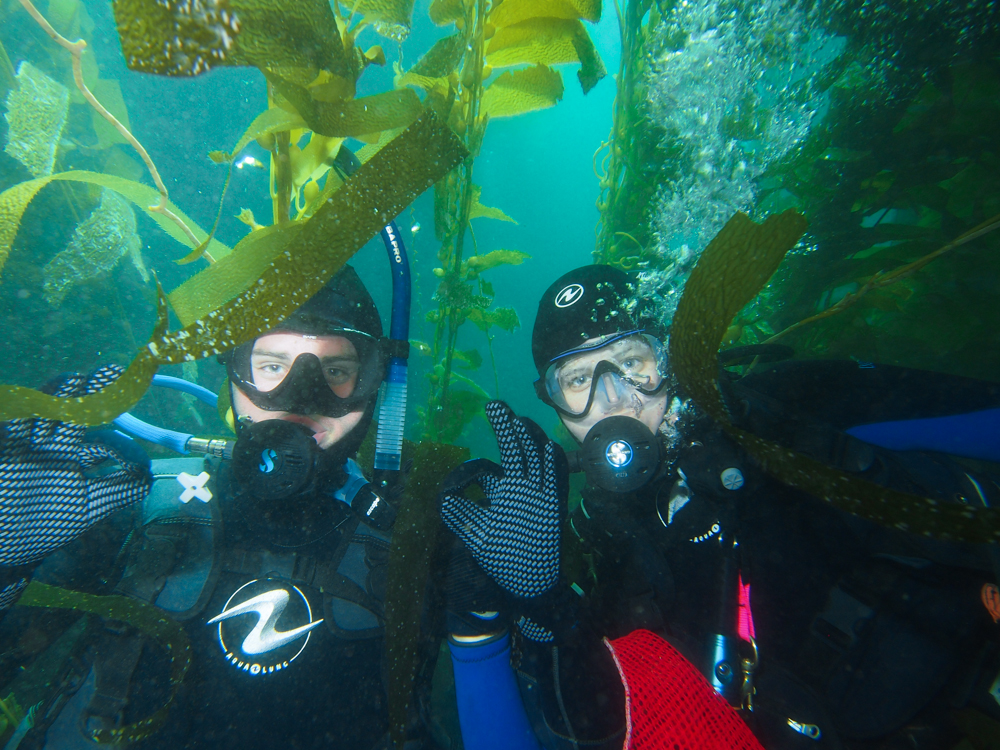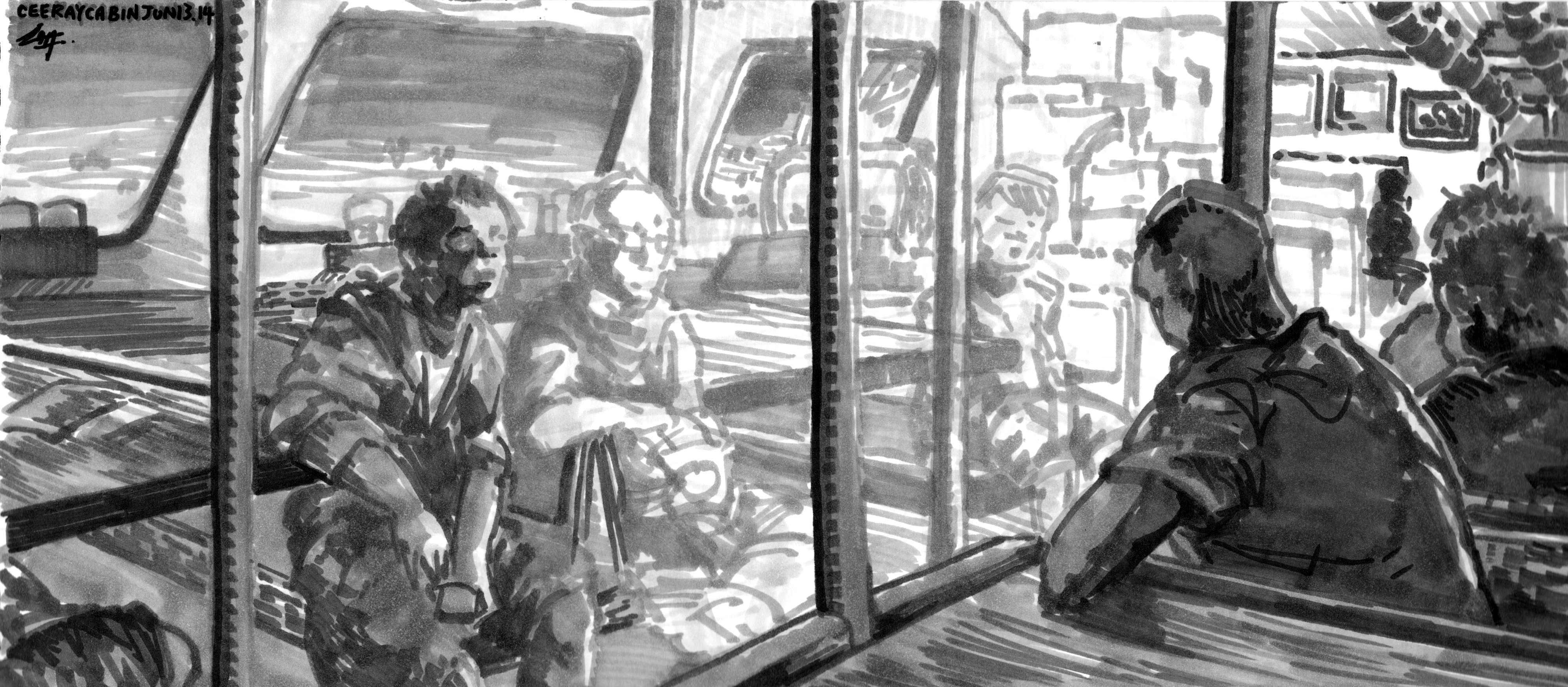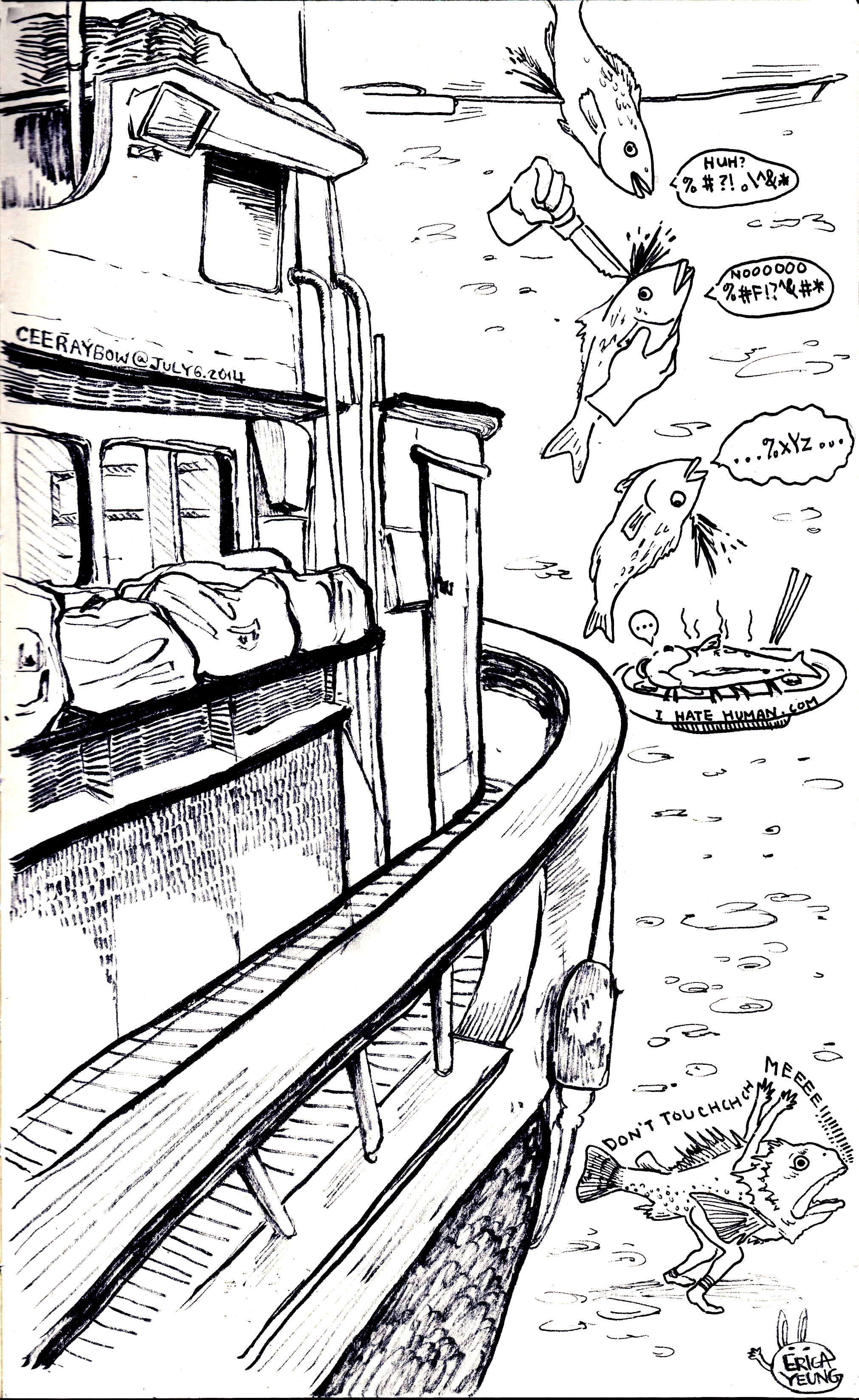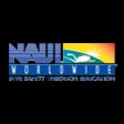Current At Santa Rosa Island 4/18/15
Diving in the kelp forest at Santa Cruz Island.
“The current is pretty strong, but you should be able to make it,” James, a Peace crew deckhand, reported back after jumping into the water at our first dive site. We were outside Nunya Reef at Santa Rosa Island.
Thomas explained that we would make our giant stride off the bow, stepping as close to the anchor line as possible, and swim for the line. If we couldn’t immediately grab hold, we would be swept toward the back of the boat where we would have to abort the dive and board the swim step. I had no practice swimming in current, but I was determined to get to that anchor line.
Once I dropped into the water, I felt the current rip at me immediately. Visibility was low but I could see the anchor line and I kicked for it. Still, it remained just out of my reach and I was exerting too much energy, burning too much air. The idea of aborting the dive was crushing, I was so close. In one last-ditch effort, I kicked harder and threw my arms out in front of me. Megumi, one of my assistant instructors, was hanging on the line and my hands grazed her fin. I grabbed hold. I was worried that I’d yank her right off the line, but hopeful that she might be able to pull me to it.
She turned her head and grabbed my arm, guiding me as I continued to kick and finally my fingers wrapped around the rope. Once I was secured on the line I laughed into my regulator. It was so fun to hang on and let the current blow my body out behind me like a windsock. As I relaxed, my breathing slowed, and I descended the line after Megumi.
Down at the bottom, the current was calmer and we had a chance to explore the reef. The visibility was about fifteen feet. Once I let go of the anchor line I saw that my entire group had made it! We were seventy feet deep and soon it was time to ascend back up the line. I was a lot more comfortable with the pull of the current on my way up, enjoying the power of it, it was an exciting thing to behold.
There is nothing like a hot meal to recharge a group of divers. Courtesy of Peace crew chef Steve, the Ocean Safari Dive Team enjoyed a fresh breakfast as we made our way to Santa Cruz Island for our next dive.
I plunged into the water after Megumi and met up with my buddy and the rest of my group at fifteen feet. At a depth of fifty feet, we began exploring the underwater rock formations. I watched Thomas shine his light into one of the crevices, but I couldn’t see what he was looking at. He grabbed my arm and pulled me closer, and I followed the direction of his light as I swam inside. I thought that he might be showing me a lobster or eel, but when I got in closer I came face to face with a beautiful horn shark (Heterodontus francisci). I’d never seen a shark outside of an aquarium before, it was enthralling.
Back on the boat once again, we enjoyed some of the luxuries only found on the Peace. Divers warm up in-between dives by pouring hot water from the boats jacuzzi down their wetsuits! Our captain dropped anchor at Bowen Point, on Santa Cruz island for our third dive. I kept my buddy close and followed Thomas, but soon we realized that our group was missing two divers. We searched for them briefly underwater before ascending to the surface. My buddy and I took a compass heading before descending and heading back to the boat.
Despite getting separated underwater, the missing divers navigated their way back and we all rendezvoused on the boat before our captain pulled up the anchor a third time and moved us to Pink Ribbon Boilers, our last dive site of the day, on Santa Cruz island. Before jumping off the boat, my buddy and I took a compass heading and then performed our direct descent. We explored through the kelp and saw California Garibaldi (Hypsypops rubicundus), urchins (Centrostephanus coronatus, Strongylocentrotus purpuratus, Strongylocentrotus franciscanus), sea cucumber (Parastichopus californicus), sea hares (Aplysia californica), schools of blacksmith (Chromis punctipinnis), and sand dollars (Echinarachnius parma).
As part of Ocean Safari’s NAUI Advanced Open Water Certification course, my instructors guided me through challenging conditions and helped me to progress my level of skill and competence under water. Back on board I logged my dives and relaxed in the hot tub as the Peace made its way back to the harbor, taking the Ocean Safari Dive Team back home.
Written by Sara Hall
Dive Blog February 21, 2015. Anacapa Island.
Photo by Chris Shi
“Go, go, go, go!” Crew members called out as the boat erupted into a flurry of motion. Several divers hit the water in quick succession, creating a staccato rhythm as they stepped off the boat into the current.
The first dive of the morning was a semi-drift dive. After extensive planning, Ocean Safari teamed up with the Explorer to offer this unique semi-drift experience for divers. But, as a novice diver, I didn’t have the skill for this kind of dive yet. I sat perched on the Explorer’s upper deck, my favorite place on the ship, as the action unfolded below me.
I watched in awe as the current slowed, leaving the freshly departed divers bobbing in the water next to the boat instead of drifting. Suddenly, the divers didn’t need to hurry off the boat. The sense of urgency was gone, replaced by a surge of excitement. It was a beautiful day at Anacapa Island and the conditions were exceptional for diving.
The first group of divers climbed back onto the boat and exhilaration hit me like a bolt of electricity. I was ravenous to get in the water. My first dive of the morning was a skin dive lead by Thomas and Norbert. Kelp blanketed the surface thickly, creating the odd sensation of crawling on the water as if it were a solid mass.
This was my first free dive. I struggled to descend against the buoyancy of my wetsuit, flapping my fins helplessly against the surface. Thomas and Norbert made it look so easy! I wanted to be able to do that. What I enjoyed most about the skin dive was that it gave me a little taste of what I could expect once I got back on the boat and donned my dive gear. From the surface of the water, I could see forty feet down to the bottom. I’d never experienced visibility like that.
After gearing up, I hit the water a second time and felt adrenaline rush through me. In seconds, I was surrounded by marine life including urchins, starfish, sea slugs, and countless creatures I couldn’t name. The kelp forest was encompassing, surrounding us like long fingers reaching up from the ocean floor.
As a group, we demonstrated a few skills for Thomas and Norbert including mask flooding and neutral buoyancy. Then came my favorite part, exploring through the lush kelp forest. I quickly became enthralled by the underwater world. There was so much to see!
Lunch was an interesting experience, as it seemed just as exciting for some of us. We had many hungry divers. But, I couldn’t stop thinking about getting back into the water. There was so much wonder and discovery at my fingertips. I wanted to explore. I wanted to see more.
The last dive of the day didn’t disappoint, offering the same remarkable visibility as the previous. I’d never been on a dive where I could see so clearly, so vividly. It seemed endless. It blew me away.
My first trip with Ocean Safari, also my first dive since certification yielded tons of new friends and adventures. The Explorer is an excellent boat with a professional and hospitable crew. I can only describe the day as phenomenal. I enjoyed every minute of it. Ocean Safari is not your average dive shop; they rose above my expectations, striving to offer unique and one-of-a-kind experiences, giving divers the best that California has to offer. The beauty I saw underwater was enough to leave me breathless. Never hold your breath! Oh, right…
Look for me on your next dive trip, lets buddy up!
Written by Sara Hall
Big Sur Trip
Big Sur, California, has got to be one of the most beautiful places in California. Maybe even the whole US. Tourists from around the world flock to this gorgeous gem to see its clear turquoise waters, with majestic rugged coastline, surrounded by tall luscious trees. I first fell in love with this place during my sophomore year of high school (2007) on a school trip. I didn’t even know that such tropical looking waters existed in temperate oceans.
Photo: Haruka Ito, 2007. No color adjustments, no filter. It’s the real thing taken by a little point and shoot I had at the time. Isn’t it beautiful?
When I saw the trip listed on the OSDT 2014 calendar, I couldn’t be more excited. I wanted to be the first one signed up! Who wouldn’t want to dive in that stunning place?
The first day of the trip, we toured another beautiful city in California, Santa Barbara. We visited the Santa Barbara Maritime Museum, where we got a special private tour by Gabriel’s professor from UC Santa Barbara. This museum houses the spectacular lens from the Point Conception lighthouse, hand crafted in the 1800s. A lens like that, built with numerous precise, handmade glass pieces, can no longer be made, even with modern technology. And the modern replacement cannot shine as bright as that one. The museum is filled with history, not only of the lighthouse, but also the history of how Santa Barbara is the birthplace of commercial diving. The exhibit also highlighted surfing, submarines, rowing, and shipwrecks, so pretty much anyone who loves the ocean will enjoy this museum.
After eating at a harbor side restaurant, which used to be Gabriel’s favorite places to treat himself after long study sessions, we headed to Morro Bay where the boat was docked. The boat is nicer than all the usual local boats we charter! It is the biggest boat, and the galley is so wide that no one has to worry about bumping into each other while walking through. We had a small group, so people had a whole table to themselves! There were very nice large shower rooms, not the usual cramped shower with a toilet taking up most of the space. The single bunks were the size of the usual double bunks. The back deck was so large that there was room to leave gear bags right there! They had dryers, freezers, and refrigerators for the guests to use. The food was amazing and probably the freshest meals I’ve ever had on a California dive boat. So should this be considered a local trip or an overseas trip? Well, I think the feel of it is very much like our local trips, but aboard a nice, huge boat with great food and awesome crew (kind of like a small-scale overseas liveaboard). I don’t think our California diving boats can get much better than aboard the Vision.
The dive sites were top notch. We went to pinnacles, underwater caves and canyons, and other hard-to-get-to spots. One of the highlights was swimming through Thomas’s Cave, which is a huge underwater cave with three entrances. After swimming out of the cave, I entered a spectacular little cove, where the light was shimmering through the water to the eelgrass and seaweed bed. My other favorite dive involved finding little pieces of real jade at Jade Cove, where I got a handful of jade that can be easily turned into nice jewelry pieces.
The Big Sur dives are definitely for advanced dive sites, with plenty of surge, swells, and currents (side current, down current, and currents going all directions). This means that life was abundant and the underwater scene was in full action. The reefs were teeming with life, including white plumose anemone, huge lingcod everywhere, nudibranchs I had never seen before, and purple hydrocorals. Since the water is colder, we saw many things that you can only see at deeper depths in the Channel Islands. There were vermillion and lingcod at fairly shallow depths, around 40 feet or less. This area is also unique, because there are two types of kelp in the kelp forest. From Southern California through the Channel Islands, you only see giant kelp. Giant kelp likes the warmer waters, so they’re not found in the colder Northern waters. From Alaska to Central California, you see lots of bull whip kelp that likes the cold waters. Big Sur is unique in that both types of kelp thrive in the same location. This variety of kelp creates a forest that can house a greater diversity of marine creatures. Things that can only live up north and others that can only live in the south meet and live together in unison. Another interesting marine life observation I made were the number of bat stars that scatter the sea floor in Big Sur. You might see some bat stars at Santa Cruz Island, but they are not the dominant sea star species in the Channel Islands. Also, if you are tired of seeing so many sea urchins on the local trips, Big Sur’s lack of sea urchins overtaking the landscape might soothe your eyes. (The sea otters keep the urchin population in check.) Since the Vision is the only dive boat that operates in the area, and only for two weeks out of the year, you can bet that not many people have a chance to dive in these hard-to-access pinnacles and dive sites.
Aside from diving, you can’t help but stare at the beautiful coastline. We passed by one the most photographed bridge one the West Coast (due to the beautiful design and location that makes it easy to photograph from land). This bridge, the Bixby Creek Bridge, is also the tallest single-span concrete bridges in the world. We also visited McWay Falls in Julia Pfeiffer Burns State Park. This waterfall is the tallest freshwater waterfall (84 feet) that cascades straight into the ocean on the Pacific coast. Hundreds of tourists visit the waterfall, but since there is no beach access allowed, they go on a paved walkway and view the waterfall from high above the falls and far away enough to take in the whole scenery with the turquoise cove. Unlike those tourists, the Vision went straight into the cove, and saw the waterfall up close. I’ve seen the waterfall from the far away viewpoint. To see the waterfall from sea level was one of the most memorable and special moments of the trip.
There’s just so much to do on this trip, from touring Santa Barbara, sightseeing, diving, and simply enjoying the cruise. They also have kayaks on board, if just looking at the coastline isn’t good enough. What an extraordinary trip! You’d better not miss the next opportunity to go dive at this special gem in California, aboard the most comfortable local dive boat, the Vision.
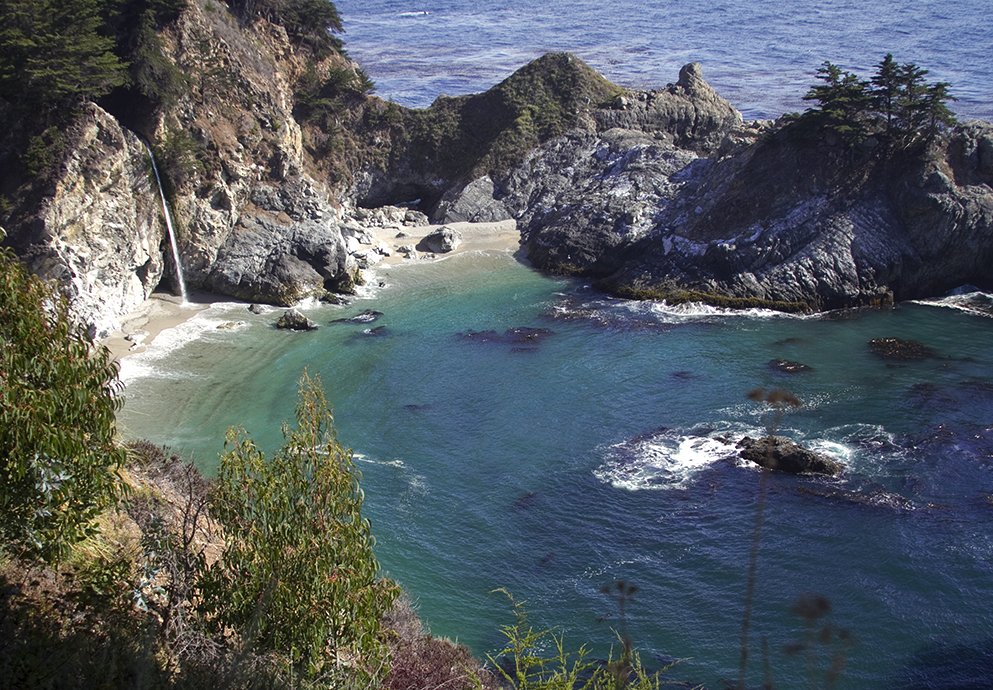
Photo: Haruka Ito, 2012. View of McWay falls that tourists see
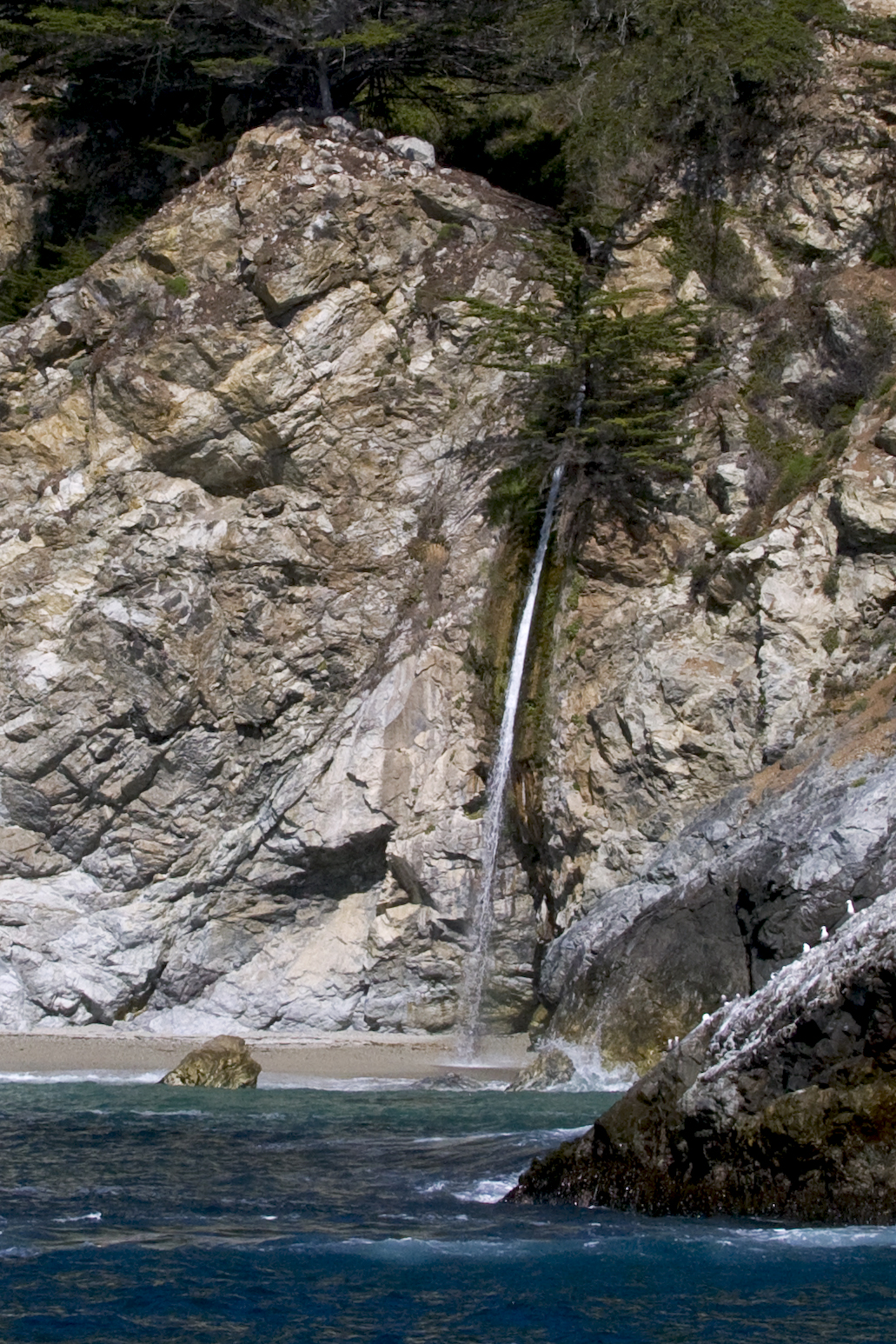
Photo: Haruka Ito, 2014. View of McWay falls aboard the Vision
Dive Blog May 4, 2014 Anacapa Island
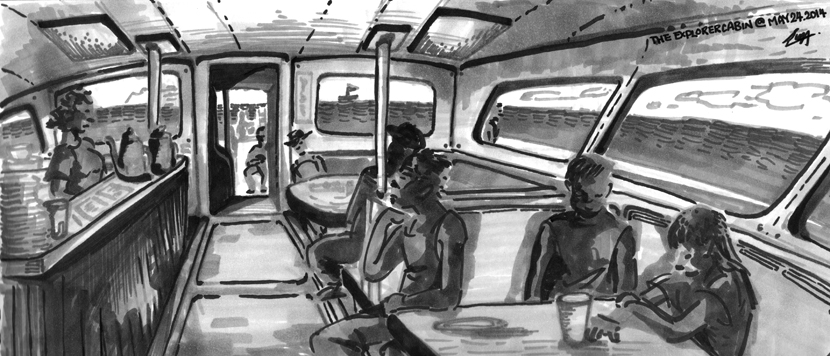
Explorer Cabin Sketch by Erica Yeung
Dive Blog May 4, 2014 Anacapa Island
Today’s dive trip to Anacapa Island on the Explorer included new personal records, challenging sites, rescue practice, and as usual, a wonderful experience with divers, crew, and dive-sites alike!
The first dive of the day holds my current deepest dive! 115 feet! At first, I was nervous about the depth, on top of the low visibility and current. But when I found myself comfortable at 85 feet, my anxiety subsided. I was excited to see the plane wreck; unfortunately, the anchor was placed too far to safely reach the wreck. Even though I was a little disappointed, I was still thrilled to have dove so deep without any complications. The excitement didn’t end there; I practiced important rescue skills after.
When we got to the next site, Fish Camp, Luis helped refine our rescue towing skills. It was a nice chance to do some surface swimming and practice my kicks. I noticed that my kicks were too small and frequent, so I ended up wasting energy that I could have used to tow my buddy back to the boat. After successfully saving our victims, we had time to practice our pike dives.
The group didn’t seem to have a problem going under. One person (Ian) was even able to get sand from 25 feet deep. I on the other hand, could barely break the surface. I felt like a Margikarp helplessly splashing around. Thankfully, Luis told me that I needed to bend my top half of my body straight down , lift my legs, then kick. I was able to go down, but still had trouble going deeper than 5 feet. Again, Luis helped my techniques. Since we had to return to the boat after, I didn’t get the chance to practice again. However, I was able to practice another skill during the next dive.
At the same site, we enjoyed the vibrant environment while looking for a shallow area to practice our E.S.A. (Emergency Swimming Ascent). This skill was rather easy to carry out; however, I was shocked to have forgotten how to put on my weight belt while in the water! A basic skill that I seldom used needed to be refreshed.
For our last dive, our group faced the most challenging conditions of the day: surge, current, and low visibility. Also, we briefly discussed how to pull unconscious people out of the water. I need to work on my control because I kept hitting/crashing into other divers or rock formations. I also need to build up my stamina because the current pushed us back and our group had to swim for a long time until we returned to the boat.
Overall, this trip showed me that even though I felt okay with my diving, I have lots of room for improvement. I had lots of fun talking, eating, diving, and sleeping. I am looking forward to more fun diving and skill refining in the near future! Happy diving!
Written by Kristiana Rendon
Illustration by Erica Yeung


